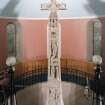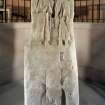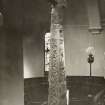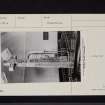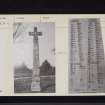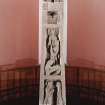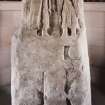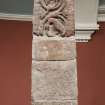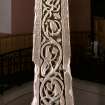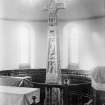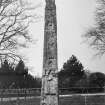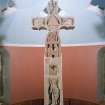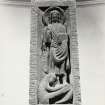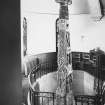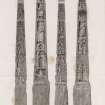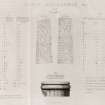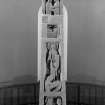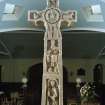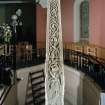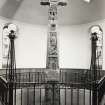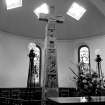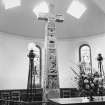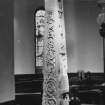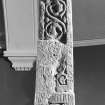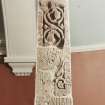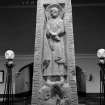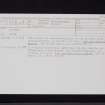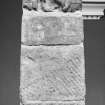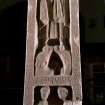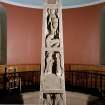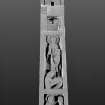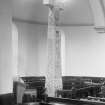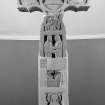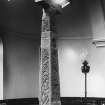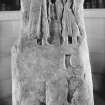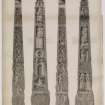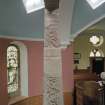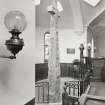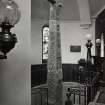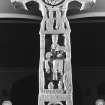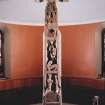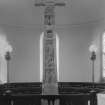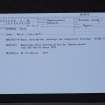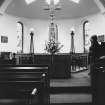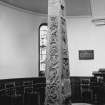Following the launch of trove.scot in February 2025 we are now planning the retiral of some of our webservices. Canmore will be switched off on 24th June 2025. Information about the closure can be found on the HES website: Retiral of HES web services | Historic Environment Scotland
Ruthwell Cross
Cross (Anglian), Rune Inscribed Stone (Anglian)
Site Name Ruthwell Cross
Classification Cross (Anglian), Rune Inscribed Stone (Anglian)
Alternative Name(s) Ruthwell Church
Canmore ID 66586
Site Number NY16NW 4
NGR NY 10059 68219
Datum OSGB36 - NGR
Permalink http://canmore.org.uk/site/66586
First 100 images shown. See the Collections panel (below) for a link to all digital images.
- Council Dumfries And Galloway
- Parish Ruthwell
- Former Region Dumfries And Galloway
- Former District Nithsdale
- Former County Dumfries-shire
Ruthwell 1 (Ruthwell Cross), Dumfriesshire (St Cuthbert): inscribed Anglian cross
Measurements: H 5.20m; W base 0.69m, shaft 0.53m tapering upwards to 0.33m, upper arm 0.23m; D base 0.46m, shaft 0.46m tapering upwards to 0.23m.
Stone type: red sandstone
Place of discovery: NY 1006 6820
Present location: in Ruthwell Parish Church.
Evidence for discovery: first recorded around 1600, the cross stood intact at Ruthwell until 1642 when an edict of the General Assembly of the Church of Scotland ordered its destruction. The larger fragments were re-used as benches inside the church until restoration work in 1772 when they were taken out into the churchyard, where other fragments lay. The minister, Rev Henry Duncan, had the cross re-erected in the manse garden in 1823, commissioning a new fragment to replace the missing side-arms and centre of the cross-head. The top arm was added back to front. Publication of Duncan’s drawing of the cross led in 1844 to the recognition that the runic inscription relates to the Anglo-Saxon religious poem known as ‘The Dream of the Rood’. The cross was taken into state care in 1887 and taken into the church to stand in a specially designed new apse. In 1931 a fragment of an original side-arm was found in the manse and displayed alongside the restored cross.
Present condition: originally carved in two sections joined by a mortise and tenon joint, the felling of the cross caused the lower section to break into two and the upper section into at least five fragments. The centre of the cross-head and most of the side-arms are still missing, though presumably somewhere in the churchyard. The carving is damaged and worn but reasonably clear.
Description
This magnificent cross is carved in deep relief on all four faces of the shaft and faces A and C of the top arm of the cross-head. The base of the shaft is rectangular, above which it tapers upwards, and the arms of the cross-head are cusped. Each carved face is bordered by a flat-band moulding. Faces A and C of the shaft each bear four figural panels of unequal sizes and separated by flat-band mouldings, the top panels being above the joint between the two sections of the monument. Faces B and D are carved with long panels of continuous inhabited vine-scroll. The mouldings on faces A and C of the shaft bear inscriptions in Latin, which describe the enclosed figural scenes, while the vertical mouldings on faces B and D bear an inscription in Anglo-Saxon runes, which is part of a poem ‘The Dream of the Rood’. The iconography of the figural panels relates to the New Testament, and the poem, narrated by the cross itself (the rood), tells the story of the Crucifixion.
Face A (north). On the top arm is carved a bird on a twig with berries and on the lower arm two frontal figures. The top panel on the shaft bears a frontal robed figure with nimbus, carrying a lamb, interpreted as St John with the Lamb of God. The next panel shows a large robed figure with nimbus, standing frontally with feet resting on two animals, Christ above the beasts. Below is a panel with two robed figures with a large round object between them, seen as Paul and Anthony in the desert sharing bread. The next panel shows a figure on horseback holding a small figure and is interpreted as the flight of the holy family into Egypt. The basal section is plain but uneven.
Face C (south). The top arm bears a human figure in profile with a bird, possibly the apostle John with his eagle, and the lower arm an archer in profile with a bow. The top panel on the shaft is carved with two human figures in profile and facing one another, possibly Mary and Martha. The next panel shows a frontal figure with a nimbus, holding a square object, and at his feet a bent figure in profile, interpreted as Mary Magdalene washing the feet of Christ and drying them with her hair. Only the upper part of the next panel survives, showing two figures in profile facing one another, that on the left with a nimbus, though to represent Christ healing the blind man. Th next panel down depicts two frontal figures, each with a nimbus, seen as the Annunciation. The base of the shaft bears a cross, possibly added later.
Faces B and D both bear long panels of vine-scroll with berries, the scrolls of which are inhabited by birds and animals, both frontal and in profile.
It has been argued that this monument was originally an obelisk, to which an upper section with a cross-head was added within the early medieval period. There is now a huge body of published comment and analysis about the Ruthwell Cross.
Date range: late seventh to mid eighth century.
Primary references: Stuart 1867, pls 19-20; ECMS pt 3, 442-8; Cassidy 1992; Stancliffe 2017.
Desk-based information compiled by A Ritchie 2019.
NY16NW 4 10059 68219.
(NY 1010 6822) Runic Cross (NR) (Site of)
OS 6" map (1957)
For Ruthwell (parish) Church and interlace-decorated architectural fragment lying at the foot of the cross, see NY16NW 40.
An Anglian high cross with runic inscriptions, one of the major monuments of Dark Age Europe, which dates probably from the end of the 7th century.
V G Childe 1961
Traditionally the original site of the cross was at NY16NW 36 Priestside (name: NY 102 662) on the Solway shore (G Seaton 1887). It was standing in the church, (RCAHMS 1920) or churchyard, (J R Allan and J Anderson 1903) when it was thrown down and broken, c.1642. The broken fragments remained in the church until some time after 1772 when they were again removed to the churchyard. In 1802 the cross was erected in the manse garden where, restored in 1823, it remained till final removal to its present position in the church (NY16NW 40) in 1887.
The published site is, therefore, that on which the cross stood for part of the 19th century, and does not represent the original site.
Information from OS (DA), 23 May 1966.
Photographic Survey (April 1954)
Photographic survey by the Scottish National Buildings Record in April 1954.
Field Visit (31 October 1967)
NY 1005 6821. Authorities confirmed. The original siting could not be ascertained.
Visited by OS (RD) 31 October 1967.
Publication Account (1986)
This is the most important Anglian cross in Scotland and a monument of international reputation. It stands 5.2m high at the sunken centre of a semicircular apse specially erected for the purpose in 1887. Between
1823 and 1887 it stood at the gateway to the manse, reassembled from broken pieces which since 1642 had lain first in the clay floor of the church and then in the churchyard. As 'an idolatrous monument' it had been partly defaced, broken, and buried in order to comply with the wishes of a General Assembly in 1640. At that date, and at its first recorded mention in 1600, the cross stood inside the church. The effaced and broken portions, and the modem insertions (including the - transom, ie the bar of the cross-head), are clearly visible, but the magnifIcence of the design and its detailing transcend the damage and the stuctural surgery.
Its signifIcance, however, goes beyond the quality of the composition and its execution. It has, in the words of Professor Rosemary Cramp, 'the most complete theological programme of any surviving cross', and illustrates more perfectly than any other 'the intellectual background of Northumbrian Christianity'. It does this by coherent schemes of words and pictures: on the broad faces there are panels of carved figures and marginal texts, virtually all in Latini the narrow sides have vinescrolls inhabited by birds and beasts and runic-inscribed margins. The panels and Latin texts describe and illustrate the divinity and power of Christi the animated scrolls and the runes are related to the theme of Creation, the text being a precursor of the Anglo-Saxon poem, 'The Dream of the Rood'.
The symbolism of the carvings, suggestions about its missing pieces, the source of the design and its carvers, and its probable date, are subjects which have given rise to enough scholarly literature to paper the walls of the kirk. SuffIce to say that current opinion is in favour of an early or mid 8th century date, its closest but less homogeneous and possibly slightly earlier parallel being Bewcastle Cross in Cumbria. The style and the iconography of the two crosses may have been derived from Eastern Mediterranean models, probably through master carvers trained in one of the great monastic houses of Northumbria, perhaps from the area that is now Yorkshire. The meanings of the carvings and the texts also make clear sense in relation to the liturgical calendar and practices of contemporary Northumbria. The veneration of the Cross was important in the Northumbrian version of Roman liturgy, especially after Pope Sergius's miraculous fmding of a relic of the True Cross in 701, an event which may have inspired the erection of the Bewcastle and Ruthwell Crosses.
The north, probably originally the west, face has as its central panel the figure of Christ in Majesty with his feet resting on the heads of a pair of animals. The surrounding text reads: 'Jesus Christ the judge of equity. The animals and the serpents recognised the Saviour of the world in the desert'. The panel immediately above depicts St John the Baptist holding the Lamb, and the associated incomplete text reads 'we worship'. The corresponding panel below shows the two hermit saints, Paul and Anthony, the inscription 'St Paul and A(nthony) broke bread in the desert', the whole scene being an allusion to the Holy Mass. The lowest visible panel shows the Flight into Egypt with Mary and Child seated on an ass; the remains of the superscription read 'Mary and Jo(seph) . . :. The larger panel at the base, which has been effaced, possibly bore a representation of the Nativity.
On the south face, the central panel shows Mary Magdalene washing the feet of Christ, with an almost complete quotation: 'she brought an alabaster box of ointment; and standing behind (beside) his feet, she began to moisten his feet with tears, and with the hairs of her own head she wiped (them)' (Vulgate Luke 7: 37-8). The panel beneath represents the Healing of the Blind Man, and a fragment of the text 'And passing by (He) saw (blind) from birth' (John 9:1). Below is a representation of the Annunciation with a vestige of text from Luke 1:28 'The angel came in . . :. The much-damaged panel at the foot bore a Crucifixion scene. The Visitation is shown towards the upper end of the shaft above the Magdalene relief; it is surrounded by a runic, not Latin, text, part of which can be understood to mean 'Mary, mother of the Lord'. The panel immediately below the arm contains an archer, and a pair of unidentifIed figures occupy a corresponding position on the other side.
The head of the cross, apparently replaced the wrong way round, bears on one side an eagle as a symbol of the Ascension, and, on the other, St John the Evangelist and his emblem, also an eagle. The runic texts on the sides have been traslated and reconstructed in the following passages: '. . . God almighty stripped himself when he wanted to ascend the cross, brave before men . . .;. . . I (bore) the noble King, the Lord of Heaven, I did not dare bow; men mocked us both together; I was smeared with blood . . .;. . . Christ was on the cross; yet there eager noble men came fI'om afar to him alone; I beheld all that; I was sorely troubled with sorrows . . .;. . . They laid him wounded with arrows, weary in limb; they stood at the head of his body, they beheld there . . :.
Information from ‘Exploring Scotland’s Heritage: Dumfries and Galloway’, (1986).
Reference (1996)
The apse of the church (NY16NW 40) contains the Ruthwell Cross, the most important work in Scotland of the Anglo-Saxon Jarrow-Monkwearmouth school of sculpture. Its date, unlike that of the Bewcastle Cross (Cumbria), some of whose detail is almost identical, has been disputed, but the likeliest is the first half of the 8th century, when the Anglians were firmly in control of the former kingdom of Reheged and established a bishopric at Whithorn. The original site is also uncertain, but it is not inconceivable that the Cross was designed to stand inside an Anglian church on the present site.
J Gifford 1996.










































































































